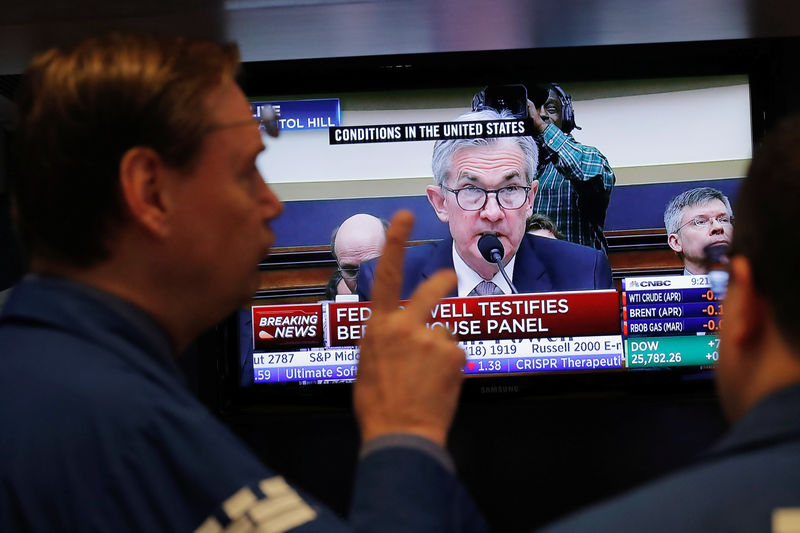Investing.com - Here are the top five things you need to know in financial markets on Thursday, March 1:
1. Powell Back On Capitol Hill
Investors looked ahead to a second appearance from Federal Reserve Chair Jerome Powell, after comments he made earlier this week revived fears that interest rates stateside will increase faster than expected this year.
He is due to testify in front of the Senate Banking Committee at 10:00AM ET (1500GMT).
In his first congressional hearing as head of the Fed on Tuesday, Powell vowed to prevent the economy from overheating while sticking with a plan to gradually raise interest rates.
Those comments rekindled speculation in equity markets over U.S. monetary tightening this year happening faster than expected. Indeed, many economists have started to forecast four rate hikes this year, compared to the three the Fed currently predicts.
2. Fed's Preferred Inflation Metric in Focus
Besides Powell, Thursday's calendar features a closely-watched report on personal income and spending for February, which includes the personal consumption expenditures inflation data - the Fed's preferred metric for inflation - at 8:30AM ET (1330GMT).
The consensus forecast is that the report will show that the core PCE price index inched up 0.3% last month, after rising 0.2% a month earlier. On an annualized basis, core PCE prices are expected to rise 1.5%, unchanged from the preceding month.
The Fed uses core PCE as a tool to help determine whether to raise or lower interest rates, with the aim of keeping inflation at a rate of 2% or below.
In addition to the inflation data, reports on weekly jobless claims, ISM manufacturing activity, construction spending and monthly auto sales will also on the agenda for today.
3. Dollar Climbs To Six-Week High
The U.S. dollar rallied to its strongest level in six weeks, boosted by bets that the Fed could increase interest rates as many as four times this year, more than the three it has previously signaled.
The dollar index, which measures the greenback’s strength against a basket of six major currencies, was last at 90.70, after hitting an overnight high of 90.74, the best level since Jan. 18.
Meanwhile, the U.S. 10-year Treasury yield stood at 2.841%, continuing to move away from a four-year high of 2.957% reached last week.
Against the yen, the dollar inched up 0.1% to $106.80.
The euro slumped to its worst level since Jan. 18 at $1.2180, hurt by political uncertainties as Italians are preparing to vote in a national election on Sunday.
The British pound fell to $1.3727, its lowest since mid-January, pressured by renewed worries over Brexit after British Prime Minister Theresa May said the EU's draft legal text published on Wednesday would undermine Britain and threaten its constitutional integrity.
4. Global Stocks Deepen Selloff
Global equities slumped for the third day in a row, as attention turned again to Fed Chair Powell and what he might hint about U.S. interest rates in fresh testimony to Congress.
Asian shares ended mostly lower, with Japan's Nikkei 225 faring the worst, closing down around 1.6%. Chinese shares bucked the trend and edged up after a private survey showed growth in China's manufacturing sector picking up to a six-month high.
In Europe, nearly all the continent's major bourses traded in negative territory in mid-morning trade. The Stoxx Europe 600 index, the region's broadest measure of share prices, fell around 0.8%, with most sectors in the red.
Meanwhile, on Wall Street, U.S. stock futures inched lower, an indication that equities may be ready to extend sharp losses from Wednesday. Dow futures were down nearly 110 points, or around 0.4%, while S&P 500 futures dipped 6 points, or about 0.3%, and Nasdaq 100 futures shed 15 points, or roughly 0.2%.
Earnings Thursday will be retail-heavy, with highlights expected from Kohl’s (NYSE:KSS), Best Buy (NYSE:BBY), Nordstrom (NYSE:JWN), Gap (NYSE:GPS), and gunmaker American Outdoor Brands (NASDAQ:AOBC).
U.S. stocks fell sharply in choppy trade Wednesday, with the Dow falling nearly 1.5%, or 380 points.
5. Oil Prices Slump Amid Rising U.S. Output
Oil prices were on the backfoot, as lingering concerns over rising production in the U.S. sent prices to their lowest levels in around a week.
U.S. oil production, driven by shale extraction, rose to an all-time high of 10.28 million barrels per day last week, according to government data, keeping it above Saudi Arabia's output levels and within reach of Russia, the world's biggest crude producer.
New York-traded WTI crude futures slipped 35 cents, or 0.6% to $61.29 per barrel, while London-listed Brent crude futures were at $64.50 per barrel, down 23 cents, or 0.4%.
